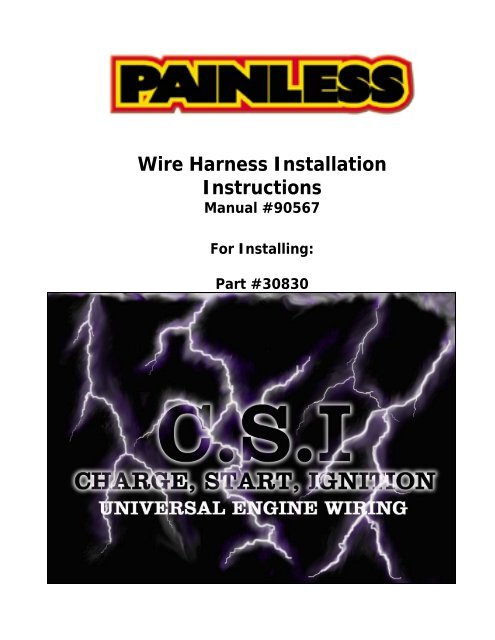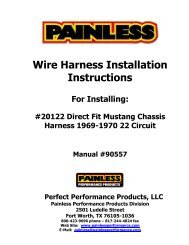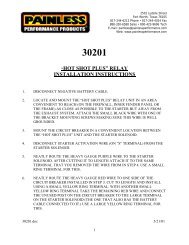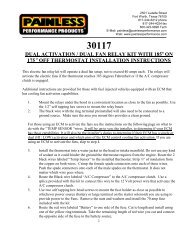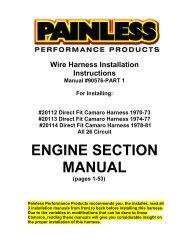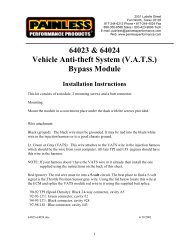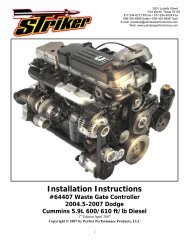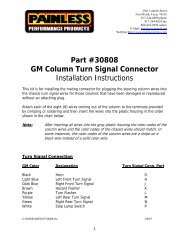Wire Harness Installation Instructions - Painless Wiring
Wire Harness Installation Instructions - Painless Wiring
Wire Harness Installation Instructions - Painless Wiring
You also want an ePaper? Increase the reach of your titles
YUMPU automatically turns print PDFs into web optimized ePapers that Google loves.
<strong>Wire</strong> <strong>Harness</strong> <strong>Installation</strong><br />
<strong>Instructions</strong><br />
Manual #90567<br />
For Installing:<br />
Part #30830
Perfect Performance Products, LLC<br />
<strong>Painless</strong> Performance Products Division<br />
2501 Ludelle Street<br />
Fort Worth, TX 76105-1036<br />
800-423-9696 phone – 817-244-4024 fax<br />
Web Site: www.painlessperformance.com<br />
E-Mail: painless@painlessperformance.com<br />
If you have any questions concerning the installation of this harness or having<br />
trouble in general, feel free to call <strong>Painless</strong> Performance Products' tech line at 1-<br />
800-423-9696. Calls are answered from 8am to 5pm central time, Monday thru<br />
Friday, except holidays.<br />
We have attempted to provide you with as accurate instructions as possible, and<br />
are always concerned about corrections or improvements that can be made. If<br />
you have found any errors or omissions, or if you simply have comments or<br />
suggestions concerning these instructions, please write us at the address on the<br />
cover and let us know about them. Or, better yet, send us a fax at (817) 244-<br />
4024 or e-mail us at painless@painlessperformance.com. We sincerely appreciate<br />
your business.<br />
Perfect Performance Products, LLC shall in no event be liable in contract or<br />
tort (including negligence) for special, indirect, incidental, or consequential<br />
damages, such as but not limited to, loss of property damage, or any other<br />
damages, costs or expenses which might be claimed as the result of the use or<br />
failure of the goods sold hereby, except only the cost of repair or replacement.<br />
P/N 90567 <strong>Painless</strong> <strong>Wiring</strong> Manual<br />
April, 2009<br />
Copyright © 2009 by Perfect Performance Products, LLC<br />
2
CAUTION: BEFORE THE REMOVAL OF YOUR ORIGINAL<br />
HARNESS AND/OR THE INSTALL OF YOUR NEW<br />
PAINLESS HARNESS, DISCONNECT THE POWER FROM<br />
YOUR VEHICLE BY REMOVING THE NEGATIVE (BLACK)<br />
BATTERY CABLE FROM THE BATTERY.<br />
NOTE :<br />
‣ A color copy of these instructions can be found at<br />
http://www.painlessperformance.com/InfoSearch/manuals.php<br />
‣ If your vehicle has an existing harness, you will want to retain it for the<br />
possible re-use of various pigtails & connector housings particular to<br />
your application. During the removal process, avoid making any<br />
unnecessary cuts and label all connectors as they are disconnected.<br />
Labeling will allow quicker and easier identification in the event you<br />
need the OEM harness for reference during the install of your new<br />
<strong>Painless</strong> harness.<br />
‣ <strong>Painless</strong> Performance Products recommends you, the installer, read this<br />
installation manual from front to back before installing this harness. Due<br />
to the variables in modifications that can be done to vehicles, reading<br />
this manual will give you considerable insight on the proper routing and<br />
installation of this harness.<br />
3
TABLE OF CONTENTS<br />
Introduction page 6<br />
Contents of the C.S.I. <strong>Harness</strong> page 7<br />
Tools needed page 8<br />
<strong>Harness</strong> routing page 8<br />
Fuse block & Fuse Block Mounting page 9<br />
Interior Connections page 10<br />
Ignition Switch page 10<br />
Gauges page 10<br />
Engine Section page 11<br />
Coil / Ignition page 12<br />
Sensor / Sending Units page 12<br />
Carburetor page 13<br />
Maxi Fuse page 13<br />
Alternator / Charging page 14<br />
Starter page 14<br />
Accessory <strong>Wire</strong>s page 15<br />
Testing page 15<br />
Troubleshooting page 16<br />
Diagrams page 17<br />
PHOTOS & ILLUSTRATIONS<br />
FIGURE 1- C.S.I. HARNESS SCHEMATIC page 7<br />
FIGURE 2- C.S.I. WIRE HARNESS KIT page 8<br />
FIGURE 3- FUSE BLOCK SCHEMATIC page 9<br />
FIGURE 4- BALLAST RESISTOR page 12<br />
FIGURE 5- MAXI FUSE page 13<br />
FIGURE 6- IGNITION SWITCH SCHEMATIC page 18<br />
FIGURE 7- TOGGLE SWITCH IGNITION w/ TOGGLE SWITCH START page 19<br />
FIGURE 8- TOGGLE SWITCH IGNITION w/ PUSH BUTTON START page 20<br />
FIGURE 9- LIGHTED ROCKER SWITCH w/ TOGGLE SWITCH START page 21<br />
FIGURE 10- LIGHTED ROCKER SWITCH w/ PUSH BUTTON START page 22<br />
FIGURE 11- GAUGE WIRING page 23<br />
FIGURE 12- CHARGE INDICATOR LIGHT ASSEMBLY page 24<br />
FIGURE 13- COIL CONNECTION page 25<br />
FIGURE 14- COIL CONNECTION (INTERNALLY RESISTED) page 25<br />
FIGURE 15- FORD DURASPARK CONNECTIONS page 26<br />
FIGURE 16- MOPAR ELECTRONIC IGNITION page 27<br />
FIGURE 17- MSD CONNECTIONS page 28<br />
FIGURE 18- DELCO ALTERNATOR page 28<br />
FIGURE 19- DELCO ALTERNATOR CONNECTOR page 29<br />
4
FIGURE 20- EXTERNALLY REGULATED FORD ALTERNATOR page 29<br />
FIGURE 21- FORD 3G ALTERNATOR page 30<br />
FIGURE 22- MOPAR EXTERNALLY REGULATED ALTERNATOR page 30<br />
FIGURE 23- GM STARTING SYSTEM page 31<br />
FIGURE 24- FORD STARTING SYSTEM page 31<br />
FIGURE 25- MOPAR STARTING SYSTEM page 32<br />
5
INTRODUCTION<br />
You have purchased what we at <strong>Painless</strong> Performance Products believe to be the easiest to<br />
install engine wire harness on the market. It is designed for easy installation, even if you have no<br />
electrical experience<br />
The C.S.I. harness is a universal weather-proof engine harness providing wiring to<br />
accommodate the Charging, Starting, and Ignition of just about any non fuel injected engine. Accessory<br />
circuits aide in re-connecting a factory fuse block, electric fuel pump, electric water pump, electric<br />
cooling fans, light switch, etc. More information on the Accessory circuits can be found on page 15.<br />
Being a universal harness you may find that some wires needed for your particular application are not<br />
included in this kit. This kit only contains the wires that are common among all Charging, Starting, and<br />
Ignition systems. All wires included in this kit can be seen in the <strong>Harness</strong> Schematic on the next page.<br />
In most cases the wires not included pertain to externally regulated alternators and factory electronic<br />
ignition systems. <strong>Painless</strong> has done it’s best to include diagrams showing wires you, the installer, may<br />
be required to add that are not included in this kit.<br />
The proper fuses have been pre-installed in the fuse block. In addition, wires are printed with<br />
their function, connection point, and in most cases a #900 series number for easy identification. This<br />
will help you identify the different circuits during installation and later on if additions to the overall<br />
system are necessary.<br />
This <strong>Painless</strong> wire harness is manufactured using high quality 600 volt, 275°F, TXL wire.<br />
Standard automotive wire is GPT, 300 volt, 176°F, with PVC insulation.<br />
into it:<br />
This complete engine wiring system has been designed with four major sections incorporated<br />
INTERIOR SECTION: Gauge connections (Water temperature, oil pressure, tachometer,<br />
gauge power / voltmeter, alt/charge indicator) and Ignition Switch<br />
ENGINE SECTION: Water temperature, oil pressure, tachometer, coil, ignition bypass, choke,<br />
battery feed, alternator, and starter<br />
ACCESSORY SECTION: 30 amp max switched power Accessory, 30 amp max constant<br />
power Accessory, one un-fused constant battery power Accessory.<br />
FUSE BLOCK: includes 4 fused circuits<br />
6
Figure 1 C.S.I. <strong>Harness</strong> Schematic<br />
CONTENTS OF THE PAINLESS C.S.I. WIRE HARNESS KIT<br />
Refer to the list below to take inventory of all the parts in the kit. If anything is found to be<br />
missing, contact the dealer the kit was purchased from or <strong>Painless</strong> Performance at (800)423-9696. The<br />
C.S.I. Engine <strong>Harness</strong> Kit should contain the following items:<br />
• The Main <strong>Wire</strong> <strong>Harness</strong>, with Fuse Block<br />
• One Red 6 gauge charge wire<br />
• Bag Kit: Nylon Tie Wraps,1 Grommet, Bag containing Maxi Fuse parts,<br />
• Parts Box containing Terminals, Splices, Spare Fuses etc.<br />
7
Figure 2 C.S.I. <strong>Wire</strong> <strong>Harness</strong> Kit<br />
TOOLS NEEDED<br />
In addition to basic hand tools the following will also be needed:<br />
• Crimping Tool Note: Use a quality tool to avoid over-crimping.<br />
• <strong>Wire</strong> Stripper<br />
• Test Light or Volt Meter<br />
HARNESS ROUTING<br />
The C.S.I. harness has been designed with enough length to allow installation into a wide range<br />
of vehicles and applications. You may find that excessive lengths of wire will need to be cut to custom<br />
fit the harness to your particular application. <strong>Painless</strong> Performance recommends that you, the installer,<br />
route the entire harness to all connection points particular to your application before any cutting is done<br />
and before the fuse block has been mounted.<br />
Pre-routing the harness will allow you to route the harness to your liking without the issue of<br />
wire length shortages to compromise your install. During the routing process remember to keep the<br />
harness away from high heat areas, sharp edges, and moving components such as hinges.<br />
The zip ties found pre-installed on the harness were only used during the build process of the<br />
C.S.I. harness and may need to be cut or moved as the harness is routed to make your particular install<br />
cleaner and easier. In most cases it is advised to cut the tie wraps and push and pull the wire to the<br />
length needed before any actual cutting is done. This will allow you more room for connection on the<br />
opposite end of the wire.<br />
8
A firewall grommet has been provided in the Bag Kit to allow wiring to run into the interior of the<br />
vehicle.<br />
See wire #915 in the Maxi Fuse section on page 13 for information on the large rolled wire<br />
provided in the kit.<br />
FUSE BLOCK & FUSE BLOCK MOUNTING<br />
The fuse block used on this engine harness has been potted and comes with a weatherproof<br />
cover to allow for worry-free installation into off-road vehicles or for engine compartment mounting of<br />
the Fuse Block.<br />
The 4 circuit fuse block found on the C.S.I. harness has all 4 circuits pre-wired, 2 pre-fused, 2<br />
accessory. A schematic of all wires providing inputs and outputs from the fuse block can be seen<br />
below.<br />
The 2 pre-fused circuits control power to the coil (20 amp fuse), and to the gauges & electric<br />
choke (15 amp fuse). The C.S.I. harness has a built in anti-theft feature, removing the Coil fuse (preinstalled<br />
20 amp) from the fuse block will prevent the vehicle from starting.<br />
The 2 other empty fuse locations can handle a max of 30 amps each and can be used to<br />
provide power to any accessories used in your application. More information on the Accessory circuits<br />
can be found in on page 15.<br />
Figure 3 Fuse Block Schematic<br />
9
Fuse Block Mounting<br />
• Begin by finding a suitable location to mount the fuse block. The location of the Fuse<br />
Block must be easy to access, yet out of the way during operation of the vehicle.<br />
Suitable locations for the fuse block can generally be found under the dash or on the<br />
firewall. The Fuse Block supplied with the C.S.I. harness is weather proof; however,<br />
avoid mounting the Fuse Block where it may become in direct constant contact with<br />
water or in a position which could be submerged in water during operation of the vehicle.<br />
• Using the 2 self tapping screws provided in the parts kit, mount the fuse block in<br />
the desired location.<br />
INTERIOR CONNECTIONS<br />
The interior or passenger compartment connections of the C.S.I. harness include connections to<br />
the Ignition Switch and to the Gauges.<br />
Ignition Switch<br />
Some installers may decide not to use an actual keyed ignition switch. Instead you may opt to<br />
use a toggle/rocker switch to activate the switched power and a separate momentary/push button for<br />
the start function. For this type of installation, a relay must be used to activate the switched 12v power<br />
to the harness and possibly the starter. Connect your Ignition Switch wiring according to the diagram<br />
that best represents your set up. Ignition switch schematics are on page 18-23.<br />
Ignition Switch wiring of the C.S.I. harness consists of 3 wires, those wires are as follows:<br />
• Red- #934 Ignition Switch B+<br />
This wire will feed the Ignition Switch with direct battery power. It needs to be connected to the “B+”<br />
terminal of the Ignition Switch.<br />
This terminal may provide battery power to other components. If you have an existing wire(s)<br />
connected to this terminal, trace them out to find where in the vehicle it connects to. If this terminal is<br />
providing battery power to a component(s) that will be re-used, double the #934 Ignition Switch B+<br />
wire up with the existing wire(s)<br />
• Pink- #933 Ignition Switch “IGN”<br />
This wire will carry power out of the Ignition Switch to the Fuse Block and to the Alternator Exciter wire.<br />
It needs to be connected to the “IGN” terminal of the Ignition Switch.<br />
This terminal may provide switched 12v power to other components. If you have an<br />
existing wire(s) connected to this terminal, trace them out to find where in the vehicle it connects to. If<br />
this terminal is providing power to a component(s) that will be re-used, such as a factory fuse block,<br />
double the #933 Ignition Switch “IGN” wire up with the existing wire(s)<br />
• Purple- #919 Ignition Switch “Start” to “S” on Starter Solenoid<br />
This wire carries power from the Ignition Switch to the Starter Solenoid. Connect this wire to the “S”<br />
terminal or “Start” position of the Ignition Switch.<br />
Gauges<br />
The electric Gauge wiring incorporated into this kit consist of the signal wires to the Engine<br />
Coolant Temperature, Oil Pressure, Tachometer, Voltmeter, and wires necessary for a Charge<br />
Indicator / Alternator Light. Additional power and grounds for gauge must be supplied by you, the<br />
installer. Also, you may notice there is no wiring for a fuel level gauge as the C.S.I. harness only covers<br />
wiring associated with the engine and its working components.<br />
10
Gauge wiring of the C.S.I. harness consists of 5 wires, all of which can be seen in the GAUGE<br />
SCHEMATIC located on page 23 The 5 wires of the Gauge wiring are as follows:<br />
• Pink/Black- #935 Gauge/Voltmeter Power<br />
This wire shares a circuit with the Electric Choke, and is powered through the15 Amp fuse found on the<br />
Fuse Block. This wire will provide the 12 volts required for a Voltmeter to work properly and can also<br />
be used to power other Gauges. Connect this Pink/Black wire to the “I” terminal found on most<br />
aftermarket gauges, to the ignition side of your factory Gauge, or to the input side of a voltage regulator<br />
found on a factory gauge cluster. It will be up to the installer to make the appropriate splices or jumper<br />
power to more than one location. An illustration showing these jumper wires can be seen on page 24.<br />
• Purple/White - #923 Tachometer to Coil “-“<br />
This wire will provide the Tach. signal from the Coil or Ignition box to the Tachometer. If you are reconnecting<br />
to a factory Tachometer, make sure your Tach requires this type of signal. Not all factory<br />
Tachometers work with this type of signal, some early Ford factory installed Tachs required a Coil “+”<br />
signal. Consult a factory specific schematic for these Tach. connections<br />
• Light Green - #921 Coolant Temp. Gauge to Coolant Temp. Sensor<br />
This wire will provide the Coolant Temp. Gauge a signal from the Coolant Temp Sensor. Connect this<br />
Light Green wire to the “S” terminal found on most aftermarket gauges, or to the signal side of your<br />
factory Gauge. This wire will not be connected if you are using a mechanical gauge.<br />
.<br />
• Light Blue/Black - #922 Oil Press. Gauge to Oil Press. Sending Unit<br />
This wire will provide the Oil Pressure Gauge a signal from the Oil Pressure Sending Unit. Connect this<br />
Light Blue/Black wire to the “S” terminal found on most aftermarket gauges, or to the signal side of your<br />
factory Gauge. This wire will not be connected if you are using a mechanical gauge.<br />
• White - #914 Charge Ind. / Alternator Exciter<br />
This wire will be a loop in the Gauge section of wires and carries Switched 12v power from the Ignition<br />
splice found on the harness to the Alternator. DO NOT CUT THIS LOOP if you do not have an<br />
Alternator Indicator light on your factory Gauge cluster, or do not wish to install a charge indicator wire.<br />
If this loop is cut, and not connected to some kind of indicator light, your charging system will not<br />
operate.<br />
In order to make the connection to an Alternator light on a factory cluster or to a charge indicator<br />
light, the loop must simply be cut. You will now have 2 white wires. These 2 wires will need to connect<br />
to the power and ground side of the indicator light. It does not matter which wire goes where on the<br />
light. The resistor provided with this kit will need to be installed between the 2 wires, an illustration<br />
showing this connection can be found on page 25.<br />
The Charge Indicator will only work with the key in the “On” position when the engine is not<br />
running; this is because the engine is not charging. The Indicator will only be “On” when the alternator<br />
is not charging, if at anytime the Indicator is “On” with the engine running, you are having charging<br />
issues.<br />
ENGINE CONNECTIONS<br />
The essential portion of the C.S.I. harness is the Engine Connections. These connections<br />
consist of sending unit connections for electric Gauges (water temperature & oil pressure), Coil/Ignition<br />
connections (coil power, start/ignition bypass, & tachometer signal), Electric Choke, Alternator & Maxi<br />
Fuse, and Starter Solenoid.<br />
11
Coil / Ignition<br />
The Coil / Ignition wiring included in the C.S.I. harness consist of 3 wires. The connections of<br />
these 3 wires will vary according to what type of ignition system you are running. If you are using an<br />
aftermarket Ignition system, consult the manufacturer’s instructions for proper installation of their<br />
ignition system. If a factory ignition system is being used, a factory schematic of the system will aide in<br />
properly re-connecting. Some of the wires required for factory Ford DuraSpark or Mopar Electronic<br />
ignition system are not included in the kit. Schematics of both systems, along with GM and a common<br />
aftermarket system, have been provided. These illustrations are on page 25-28.<br />
The 3 wires that make up the Coil / Ignition portion of the C.S.I. harness are:<br />
• Pink - #920 to Coil “+”<br />
This wire carries switched 12v power from the Fuse Block (20 amp fuse) to the Coil / Ignition System.<br />
The connection of this wire depends greatly on what type of system you are running. A ballast resistor,<br />
supplied with the harness and seen in the photo to the<br />
left, will be needed if you do not have a newer internally<br />
resisted coil. Neglecting to use the supplied ceramic<br />
ballast resistor on a coil that requires a resisted 12v<br />
supply, will cause the coil to quickly overheat leading to<br />
complete coil failure. Connect this Pink wire according to<br />
the one of the diagrams shown on page 25-28 that best<br />
represents your setup.<br />
• .Brown - #970 Ignition Bypass<br />
This wire comes from the “I” or “IGN” terminal of the starter solenoid and will ensure the Coil has a full<br />
12v during engine start up. Connect the Brown wire to the “+” side of the Coil. Those using an<br />
aftermarket Ignition system or internally resisted coil may find that this wire is not needed in your<br />
application.<br />
• . Purple/White - #923 Tachometer to Coil “-“<br />
This wire will provide the Tach. signal to the Tachometer from the Coil or Ignition box. The Purple/White<br />
wire will connect to the “-”side of the coil or to the Tach output on your ignition box.<br />
If you are re-connecting to a factory Tachometer, make sure your Tach requires this type of<br />
signal. Not all factory Tachometers work with a signal from the “-“ side of the Coil, some early Ford<br />
factory installed Tachs required a Coil “+” signal.<br />
Sensor / Sending Unit<br />
The C.S.I. harness includes 2 signal wires for electric Engine Coolant Temperature and Oil<br />
Pressure gauges. These wires will not be connected if you are using mechanical gauges. These 2<br />
wires can be seen in the GAUGE SCHEMATIC on page 23, they are:<br />
• Light Green - #921 Coolant Temp. Gauge to Coolant Temp. Sensor<br />
This wire will provide the Coolant Temp. Gauge a signal from the Coolant Temp Sensor. Connect this<br />
Light Green wire to the Engine Coolant Temperature sensor. This sensor is usually located in the intake<br />
manifold or on the side of a cylinder head. Some factory fuel injection engines had 2 coolant temp<br />
sensors, one for the ECM and one for electric cooling fans. In most cases, these type of sensors will<br />
not work for gauge purposes.<br />
.<br />
12
• Light Blue/Black - #922 Oil Press. Gauge to Oil Press. Sending Unit<br />
This wire will provide the Oil Pressure Gauge a signal from the Oil Pressure Sending Unit. Connect this<br />
Light Blue/Black wire to the oil pressure sending unit. This sending unit can usually be found near the<br />
oil filter.<br />
Carburetor<br />
A single Red wire is provided for connection to an Electric Choke. This wire can be seen in the<br />
FUSE BLOCK SCHEMATIC on page 9 and also in the C.S.I. HARNESS SCHEMATIC on page 7,<br />
• .Red - #954 Electric Choke<br />
This wire provides a switched 12v source to the Electric choke. It doubles at the fuse block with<br />
the Pink/Black wire providing gauge power (15 amp fuse). This wire needs to be connected to the B+<br />
terminal on the Electric Choke. If an Electric Choke is not being used with red wire can be used as a<br />
switched 12v power source to a relay, or any other low amperage (10 amps or less) accessory. If this<br />
wire is not connected to the Choke or an accessory, the end of the wire will need to be taped and<br />
insulated to avoid it shorting to ground.<br />
Maxi Fuse<br />
This large fuse isolates the battery from the Alternator<br />
and the C.S.I. harness. This fuse, and everything required for<br />
installation, can be found in its own bag in the parts kit (seen<br />
in the photo to the left). This bag will contain:<br />
13<br />
• A MAXI FUSE Base & Cover<br />
• a self-tapping mounting screw<br />
• 70 AMP MAXI FUSE<br />
To install:<br />
• Find a suitable location for the Maxi Fuse<br />
base. It can be mounted anywhere in the engine<br />
compartment, preferably near the battery. Make sure you<br />
allow enough room to get the cover off and on, avoid<br />
mounting it near excessive heat. Also take into consideration<br />
the length of wires you need for #915, see below.<br />
• Using the mounting screw, install the MAXI FUSE Base. Using the hole found on the top<br />
of the base.<br />
• Install the 70 amp Maxi fuse or cover at this time.<br />
There are 2 wires in the C.S.I. harness dedicated for Maxi Fuse connections, they are:<br />
• .Red - #916 B+ Power<br />
This wire is the life line to the C.S.I. harness. It provides constant battery power to the fuse block and<br />
ignition switch. This wire will need to be routed to the Maxi Fuse location and cut to length. This wire<br />
will double up with the #915 Alternator Output wire on one side of the Maxi Fuse. Most of the<br />
schematics in this manual show the proper maxi fuse connections.<br />
• Red - #915 Alternator Output<br />
This large 6 gauge wire connects the Alternator output or B+ to the Maxi Fuse. This wire will also<br />
connect the Maxi Fuse to the battery. It is not built into the C.S.I. harness, but is instead just a rolled<br />
wire supplied in the kit. This is to allow the customer the ability to route the wire from the Maxi Fuse to<br />
the alternator however they choose. Connect this wire to the Maxi Fuse by doubling it with wire #916<br />
B+ Power.
The length of wire cut from #915, after it is connected to the Alternator and Maxi Fuse, will then be used<br />
to connect the opposite side of the Maxi Fuse to the vehicle’s battery power. Again, most of the<br />
schematics in this manual show the proper maxi fuse connections.<br />
Alternator/Charging<br />
Like the ignition wiring, the wiring for the charging system will vary greatly from vehicle to<br />
vehicle. The Alternator/Charging wiring included in the C.S.I. harness consists of 2 wires. The<br />
connections of these 2 wires will depend to what type of charging system you are running. If you are<br />
using an aftermarket Alternator, consult the manufacturer’s instructions for proper installation. If a<br />
factory charging system is being used, a factory schematic of the system will aide in properly reconnecting.<br />
Some of the wires required for externally regulated systems are not included in the kit.<br />
Schematics of the most common systems and alternators have been provided. These illustrations can<br />
be found on pages 28-30.<br />
The 2 wires that make up the Alternator/Charging portion of the C.S.I. harness are:<br />
• .Red - #915 Alternator Output<br />
This large 6 gauge wire connects the Alternator output to the Maxi Fuse. Connect this wire to the “B+”<br />
stud of the Alternator. A rubber boot has been provided along with an assortment of different size ring<br />
terminals to make this connection. This wire will support up to 125 amps. <strong>Installation</strong>s with Alternators<br />
exceeding 125 amps will require the installer to supply a larger gauge wire. This will be the only wire<br />
connected for one wire Alternators.<br />
• . White - #914 Charge Ind. / Alternator Exciter<br />
This white wire will provide a switched 12 v source required by some Alternators and external voltage<br />
regulators. Connect this wire according the illustration that best represents the charging system specific<br />
to your application. Alternator / Charging system illustrations that begin on page 28.<br />
A bag kit containing all of the parts necessary to connect to a GM 3 wire alternator has been<br />
provided, Figure 20 page 30. If you experience engine run on after the ignition has been turned off, the<br />
supplied diode will need to be installed in line of the white wire according to the illustration shown on<br />
page 30.<br />
Starter<br />
The Starting system wires will apply according to what kind of system you are using. Illustrations<br />
have been provided, on pages 32-33, showing the Ford, Mopar, and GM starting systems. These<br />
illustrations show the 2 wires included in the C.S.I. harness for the Starter Solenoid, these 2 wires are:<br />
• Purple- #919 Ignition Switch “Start” to “S” on Starter Solenoid<br />
This wire carries power from the Ignition Switch to the Starter Solenoid, engaging the Starter when the<br />
ignition switch is turned to the “Start” position.<br />
Extra length has been provided to this Purple wire to allow the use of a Neutral Safety Switch.<br />
<strong>Painless</strong> highly recommends the usage of a Neutral Safety Switch, like <strong>Painless</strong> part #80175. A Neutral<br />
Safety switch will not allow the engine to start while it is in gear. It will only allow the starter solenoid to<br />
be engaged with the transmission in Park or Neutral. Neutral safety switches can be found on the<br />
transmission, steering column or on the base of some aftermarket floor mounted shifters. The extra<br />
length will allow the installer to route the purple wire from the ignition switch to the neutral safety switch<br />
and cut it to length. With the length of wire cut from the ignition switch to neutral safety, you can<br />
connect the neutral safety switch to the “S” terminal of the starter solenoid.<br />
14
• .Brown - #970 Ignition Bypass<br />
This wire comes from the “+” side of the Coil and connects to the “I” terminal of the Starter Solenoid.<br />
The “I” terminal will have 12v only when the engine is cranking, thus providing a full 12v to the ignition<br />
system during engine start up. Those using an aftermarket ignition system or internally resisted coil<br />
may find that this wire is not needed in your application.<br />
ACCESSORY WIRES<br />
Three different Accessory wires can be found included in the C.S.I. harness. These wires have<br />
unlimited possibilities in how they can be used. Any wires that are un-used will need to have the ends<br />
taped and/or insulated to prevent them from shorting to ground. They Accessory wires included in the<br />
C.S.I. harness are:<br />
• .Orange – Accessory #1 Switched B+<br />
This wire can be used to power anything requiring a switched 12 volt power source, so long as the<br />
amperage does not exceed 30 amps. It is 48” longer than the other Accessory wires to allow the<br />
installer to route this wire to the rear of the vehicle to power an electric fuel pump if they desire. This<br />
wire uses the circuit on the fuse block directly below the pre-installed 15 amp (blue) fuse. It is up to the<br />
installer to install an appropriate size fuse, supplied in the parts kit, into this location of the fuse block.<br />
• .Yellow – Accessory #2 Constant B+<br />
This wire can be used to power anything requiring a constant 12 volt power source, so long as the<br />
amperage does not exceed 30 amps. This wire uses the circuit closest to the largest mounting hole of<br />
the fuse block. It is up to the installer to install an appropriate size fuse, supplied in the parts kit, into<br />
this location of the fuse block.<br />
• Red – Accessory #3 Un-Fused Constant B+<br />
This un-fused power source can be used to power a factory fuse block, or to provide battery power<br />
input to a component relay (Electric Cooling Fan, Electric Water Pump, Off-Road Lights, etc…)<br />
In some cases this harness will be installed on a vehicle that still requires use of the factory<br />
Fuse block. During the removal of the factory engine wiring, the wire(s) supplying battery power to the<br />
factory fuse block may have been cut or removed. Accessory #3 wire will now provide the battery<br />
power back to the factory fuse block to enable things like the headlights and turn signal to work again. It<br />
will be up to the installer to find the original Fuse block feed and connect Accessory #3 Un-Fused<br />
Constant B+.<br />
TESTING<br />
With the C.S.I. harness connected and using a volt meter on the VDC setting, follow these steps<br />
for the first start up. If you run across any problems at any time during the test procedure see the<br />
following Trouble Shooting section before proceeding.<br />
• Ensure all wires not used have been taped or insulated to avoid shorting the wires to<br />
ground and do a double check on all of your connections.<br />
• If all things are correct, re-connect the battery terminals to the vehicle.<br />
At this time you should have 12v on both sides of the Maxi fuse, the B+ terminal of the Ignition Switch,<br />
and to Accessory wires #2 and #3 (only if fuses have installed)<br />
• Turn the Ignition switch to the “On” position.<br />
15
At this time the “IGN” terminal of the Ignition switch, “+” of the Coil, the Electric Choke, and Accessory<br />
#1should have power. The Gauges and Alt/Charge indicator (if connected) should have also come to<br />
life.<br />
• Before turning the key to the “Start” position or pushing the “Start” button, make sure the<br />
transmission is in “Park” or “Neutral”. Try starting the Engine.<br />
With the engine running and using a voltmeter, test to see if the Charging system is working. This is<br />
done by putting the black or ground lead of the voltmeter to the ground on the battery. The red or power<br />
lead of the voltmeter will then be placed on the positive side of the battery. You will have a 13-14 volt<br />
reading if your charging system is working properly.<br />
• Turn the Ignition switch to the “Off” position<br />
At this time the engine should have died and the only components with power should be both sides of<br />
the Maxi fuse, the B+ terminal of the Ignition Switch, and Accessory wires #2 and #3.<br />
TROUBLE SHOOTING<br />
Most problems encountered during the test procedure are a result of either bad grounds or<br />
improper crimps.<br />
‣ You have no battery power to any or some of the following when the battery is reconnected: the<br />
Maxi Fuse, the B+ terminal of the Ignition Switch, and Accessory wires #2 and #3<br />
• Double check your ground at the battery, without a good ground from the battery to the<br />
frame; you will not get the proper voltage readings.<br />
• Make sure the Maxi Fuse is installed.<br />
• Double check the crimps on the ring terminals of the wires connected to the Maxi Fuse<br />
‣ You have no switched 12v power to any or some of the following when the Ignition Switch is in<br />
the “On” position: the “IGN” terminal of the Ignition switch, “+” of the Coil, the Electric Choke,<br />
Accessory #1, Gauges, and Alt/Charge indicator<br />
• Make sure the #933 wire is connected to the “IGN” or “Output” terminal of the Ignition<br />
switch; if it is connected as described, the Ignition Switch could be faulty.<br />
• If you do not have power to the Coil, check to see if the pre-installed 20 amp fuse is<br />
blown. Also, check your crimp to the terminal(s) installed on the #920 wire going to the<br />
coil and Ballast resistor.<br />
• If you do not have power to the gauge(s), check to see if the pre-installed 15 amp fuse is<br />
blown. Do you have a ground wire installed to the gauge (if required)? Make sure the<br />
#935 connected to the “I” terminal or ignition side of the Gauge<br />
• Problems with the electric choke are usually a ground problem; make sure a good<br />
ground is being made. The 15 amp fuse located on the fuse block also controls this<br />
circuit; make sure the fuse is not blown.<br />
• Accessory #1 will have problems if a fuse has not been installed or the wrong size fuse<br />
for the component being powered has been installed and is blown.<br />
• If the Charge Indicator does not work with the key in the “On” position then the bulb is<br />
either no good, or the light is not getting a good ground at the Alternator or Voltage<br />
Regulator.<br />
16
‣ You try to start the engine and it doesn’t try to start.<br />
• Before checking the harness make sure you have a fully charged battery. Engine start up<br />
requires lots of amperage and your battery may not be up to the task if it has been sitting for<br />
a length of time.<br />
• Make sure the Purple #919 wire is connected to the “S” terminal of the Ignition switch.<br />
• If you are using a push button or toggle switch, make sure you have 12v coming into the<br />
other side of the switch or to the relay depending on your setup.<br />
• Do you have the neutral safety switch connected correctly, some Neutral Safety switches<br />
also have reverse switch functions, make sure you are not connected to the reverse switch<br />
side.<br />
• If a Neutral Safety switch is being used, is the engine in “park” or “neutral” and activating the<br />
switch properly? If it is in “Park” or “Neutral”, and not activating the switch, the switch may<br />
need adjustment.<br />
• You can test to see if the switch is good by seeing if you have 12v from the start position to<br />
the switch. If you have 12v coming in but nothing coming out, it could be a faulty switch.<br />
‣ The engine cranks but will not start.<br />
• Check to see if you are getting spark. If you are getting no spark go to the second step<br />
of these trouble Shooting procedures and check power at the coil. If you are getting<br />
good power to the coil, but no spark, you could have a faulty Coil.<br />
• If you are getting spark, check the Choke on the Carburetor. You can check to ensure<br />
you have switched 12v going to the power terminal along with a good ground. Also make<br />
sure it is not open too much during cold start situations.<br />
• If using an electric fuel pump and you are powering it with Accessory #1, ensure you<br />
have a fuse installed or do not have the wrong size fuse and or blown fuse. Most electric<br />
fuel pumps require 20 amps.<br />
• If everything electrical checks out then you have a fuel delivery problem through the<br />
carburetor or fuel filter.<br />
‣ The engine continues to run even though the Ignition if turned off.<br />
• If you are using an internally regulated Alternator, the diode provided with the kit will<br />
need to be used. It needs to be installed with the stripe of the diode towards the<br />
alternator as shown in the illustration on page 29.<br />
• If you are using an external Voltage Regulator, a faulty Regulator can cause engine run<br />
on as well.<br />
Diagrams<br />
The diagrams shown on the following pages are provided in order to help you, the<br />
installer, with you particular installation. These diagrams show the most common Charging, Starting,<br />
and ignition systems from Ford, Dodge, And GM. Those doing an installation into something produced<br />
by any other manufacturer may find a diagram depicted for your particular set up is not included in this<br />
manual. If you have any questions concerning the installation of this harness or having trouble in<br />
general, feel free to call <strong>Painless</strong> Performance Products' tech line at 1-800-423-9696. Calls are<br />
answered from 8am to 5pm central time, Monday thru Friday, except holidays.<br />
You will notice the terms “Power Splice” and “Ignition Splice” on some diagrams. These terms<br />
refer to the 2 splices built into the C.S.I. <strong>Harness</strong> and can be seen in detail on page 9.<br />
17
Figure 6<br />
18
Figure 7<br />
19
Figure 8<br />
20
Figure 9<br />
21
Figure 10<br />
22
Figure 11<br />
23
Figure 12 Charge Indicator Assembly<br />
The resistor shown in the illustration above will allow the charging system to still operate in the event<br />
the Indicator bulb burns out. The switched 12v required by the Alternator goes from the Ignition Switch<br />
to the Alternator through the bulb filament. The resistor, when installed in parallel to the bulb, will allow<br />
switched 12v to reach the Alternator if the filament is no longer functional.<br />
24
Figure 13<br />
Figure 14<br />
25
Figure 15<br />
26
Figure 16<br />
27
Figure 17<br />
Figure 18<br />
28
Figure 19 Delco Alternator Connector<br />
Figure 20<br />
29
Figure 21<br />
Figure 22<br />
30
Figure 23<br />
Figure 24<br />
31
Figure 25<br />
<strong>Painless</strong> Performance Limited Warranty<br />
and Return Policy<br />
Chassis harnesses, fuel injection harnesses, and Striker ColdShot units are covered under a lifetime<br />
warranty.<br />
All other products manufactured and/or sold by <strong>Painless</strong> Performance are warranted to the original<br />
purchaser to be free from defects in material and workmanship under normal use. <strong>Painless</strong><br />
Performance will repair or replace defective products without charge during the first 12 months from the<br />
purchase date. No products will be considered for warranty without a copy of the purchase receipt<br />
showing the sellers name, address and date of purchase. You must return the product to the dealer you<br />
purchased it from to initiate warranty procedures.<br />
32
NOTES<br />
33


